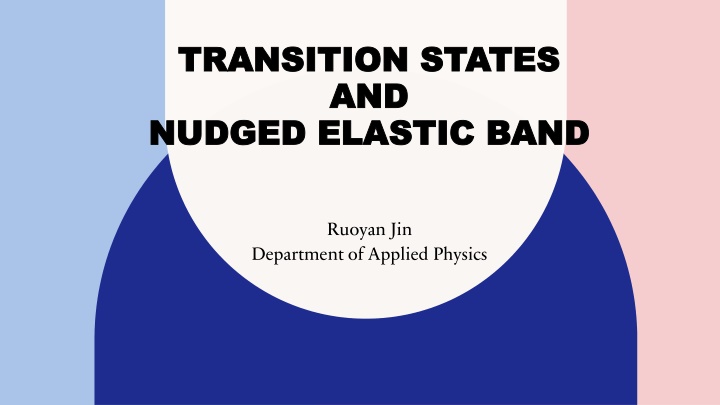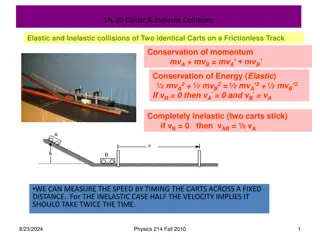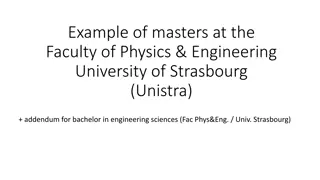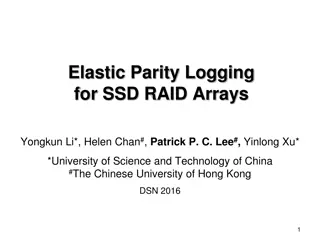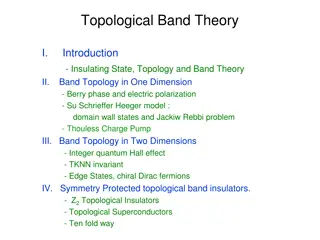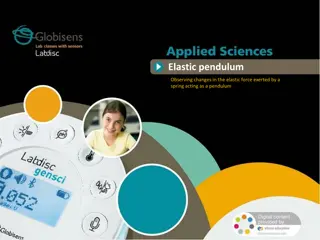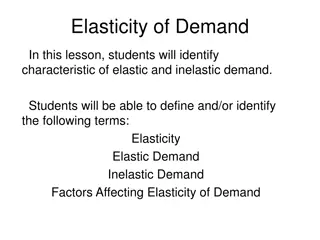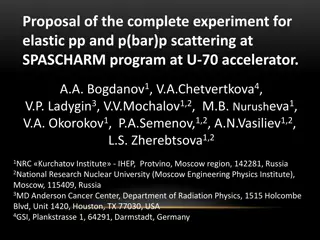Transition States and Nudged Elastic Band in Applied Physics
Description of transition states, potential energy surfaces, saddle points, minimum energy paths, and the Nudged Elastic Band method in the context of applied physics. The content explains key concepts such as transition states along reaction coordinates, the significance of potential energy surfaces, the role of saddle points in function graphs, and the use of minimum energy paths to determine reaction rates. Additionally, it introduces the Nudged Elastic Band method as a numerical approach for discovering the most probable transition pathway connecting molecular geometries in chemical reactions.
Download Presentation

Please find below an Image/Link to download the presentation.
The content on the website is provided AS IS for your information and personal use only. It may not be sold, licensed, or shared on other websites without obtaining consent from the author.If you encounter any issues during the download, it is possible that the publisher has removed the file from their server.
You are allowed to download the files provided on this website for personal or commercial use, subject to the condition that they are used lawfully. All files are the property of their respective owners.
The content on the website is provided AS IS for your information and personal use only. It may not be sold, licensed, or shared on other websites without obtaining consent from the author.
E N D
Presentation Transcript
TRANSITION STATES TRANSITION STATES AND AND NUDGED ELASTIC BAND NUDGED ELASTIC BAND Ruoyan Jin Department of Applied Physics
Basic concepts Nudged elastic band (NEB) Examples
Potential energy surface (PES): 3 The surface define the potential energy of a system as a function of one or more coordinates; if there is only one coordinate, the surface is called a potential energy curve or energy profile. [1] Fig. 2 PES for water molecule Fig. 1 A potential energy curve (1D PES) for covalent bond Note: PESs do not depend of the absolute position of the reaction, only the relative positions (internal degrees). The dimensionality of a PES is: 3N-6 (N is the number of atoms involves in the reaction). PES is a hypersurface. [1] https://chem.libretexts.org/Courses/University_of_California_Davis/UCD_Chem_107B%3A_Physical_Chemistry_for_Life_Scientists/Chapters/2%3A_Chemical_Kinetics/2.06%3A_ Potential_Energy_Surfaces#:~:text=A%20potential%20energy%20surface%20(PES,the%20positions%20of%20the%20atoms.
Transition state and saddle point: 4 A transition state is a particular configuration along the reaction coordinate, which has the highest potential energy along this reaction coordinate. [2] A saddle point or minimax point is a point on the surface of the graph of a function where the slopes (derivatives) in orthogonal directions are all zero (a critical point), but which is not a local extremum of the function. [3] The transition state structure is a first-order (Lagrange method) saddle point along a PES. [2] Fig. 4 Saddle point between two hills (the intersection of the figure-eight z-contour) Fig. 3 A saddle point (minmax point) (in red) on the graph of z = x2 y2 [2] Solomons, T.W. Graham & Fryhle, Craig B. (2004). Organic Chemistry (8th ed.). John Wiley & Sons, Inc. ISBN 0-471-41799-8. [3] Hilbert, David; Cohn-Vossen, Stephan (1952). Geometry and the Imagination (2nd ed.). Chelsea. ISBN 0-8284-1087-9.
5 Minimum energy path (MEP): The most probable transition path that connects two equilibrium states of a PES. Property 1: Any point on the path is at an energy minimum in all directions perpendicular to the path. This path passes through at least one first-order saddle point. [4] Property 2: The mechanism of reaction, and in thermal systems, the energy barrier along the path can be used to calculate the reaction rate. [4] Between any two minima (valley bottoms) the MEP will pass through a maximum at a saddle point. [1] Nudged Elastic Band (NEB): A numerical method used for the discovery of the MEP connecting two molecular geometries, generally the reagent and the product of a chemical reaction, along the PES. [5] [4] Optimization methods for finding minimum energy paths,Daniel Sheppard, et al, The Journal of Chemical Physics 128, 134106 (2008) [5] Empathes: A general code for nudged elastic band transition states search, Marco Bertini, et al,Computer Physics Communications, 271, 108224, (2022)
6 The NEB is a chain-of-states method in which a string of images geometric configurations of the system is used to describe a reaction pathway. These configurations are connected by spring forces to ensure equal spacing along the reaction path. Upon convergence of the NEB to the MEP , the images describe the reaction mechanism, up to the resolution of the images. [5] Fig. 5 Pictorial representation of a reaction path computed with NEB [1]
7 Fig. 6 The components of NEB forces [4] The perpendicular force is the gradient of the potential that pulls the system towards the true MEP.
8 CI-NEB: One of the images is made to climb up along the elastic band to converge rigorously on the highest saddle point. Fig. 8 CI-NEB, regular NEB [6] Fig. 7 Flowchart for NEB method (CI: Climbing-image NEB, Descending Image) [5] [6] A climbing image nudged elastic band method for finding saddle points and minimum energy paths, Graeme Henkelman et al, JOURNAL OF CHEMICAL PHYSICS, 113, (2000)
9 Fig. 9 Example1 [4] Fig. 10 Example2 [7] Related topics: transition state theory, energy barrier, reaction rate, vibrational frequency,Arrenius function [7] First-principles study of the stability and migration of Xe and Cs in U3Si, Ruoyan Jin et al, J. Phys.: Condens. Matter, (2022)
